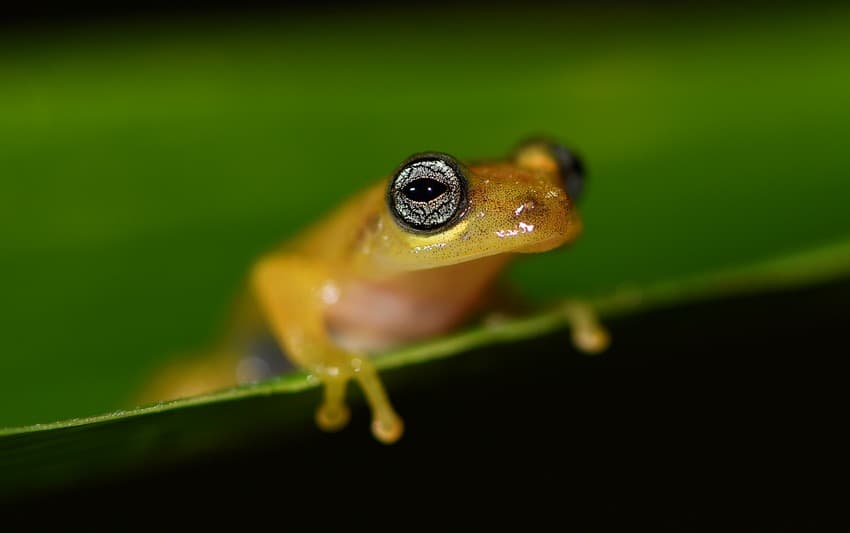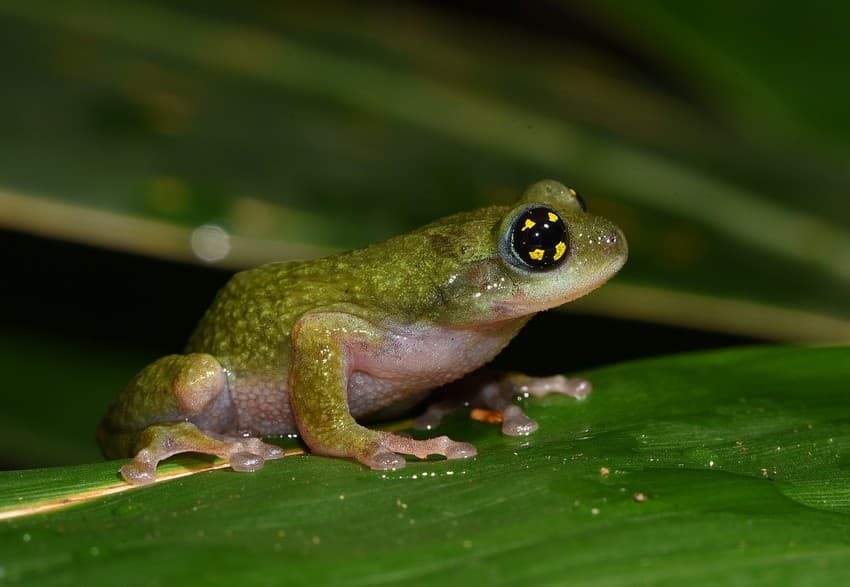In August 2016, we finally decided to fulfill our longstanding dream of spending quality time observing the herpetofauna of the Kalakkad Mundanthurai Tiger Reserve (KMTR) of Tamil Nadu. It took us seconds to convince Vishnupriya Sankararaman (Shashank’s wife), who is currently pursuing a Ph.D. on the impact of agro-plantations on stream amphibian diversity of the Western Ghats to join us on what promised to be a spellbinding expedition.
The Günther’s bush frog Raorchestes chalazodes resting on a bamboo stem. The name chalazodes comes from Greek ‘chalaza’, meaning ‘grain’ and ‘odes’, refers to the white granulation on its body. Photo: Anish Andheria.
The Western Ghats is known to be a long contiguous mountain range along the west coast of India. However, a closer look reveals 13 distinct mountain ranges. The altitudinal isolation provided by these mountain ranges along with multiple glaciation events has played a critical role in speciation of flora and fauna of the region. One of the most prominent features is the Palghat Gap, which splits the ghats into two. However, not many know about another small gap near its southernmost tip, called the Shencottah Gap. This geographical barrier has resulted in the speciation of two endemic birds from their northern relatives. These were recently described as Ashambhu Sholakili (earlier known as White-bellied Shortwing or White-bellied Blue Robin) and Ashambhu Chilapan (earlier known as Grey-breasted Laughingthrush).
The Shencottah Gap, however, has played a much greater role in amphibian speciation, as they are far more sedentary than birds. The hill range south of Shencottah Gap is called Agasthyamalai Hills. There are three Protected Areas in this range, namely Peppara and Shendurney Wildlife Sanctuaries in Kerala and KMTR. Of these, KMTR has always been a favourite among naturalists and wildlife biologists, as it supports one of the most diverse assemblages of herpetofauna in the Indian peninsula. Almost all frog genera found in KMTR retain some amount of endemism. Among these, of most interest are bush frogs belonging to the Genus Raorchestes, which is possibly the most diversified of all frog genera in the region.

Manohar’s bush frog Raorchestes manohari is named after T.M. Manoharan, Principal Chief Conservator of Forests, Kerala. Photo: Anish Andheria.
The Agasthyamalai Hills have two frogs from this genus that are extreme habitat specialists and are known to live only in bamboo! And, we were hoping to attempt the impossible – locate these enigmatic species amidst a sea of bamboo reeds, which initially seemed more futile than searching for the proverbial needle in a haystack. At the top of our list was the Günther’s bush frog Raorchestes chalazodes, known to be partial to Ochlandra bamboo reeds. In fact, this species spends its entire life inside a single node of the bamboo, leaving its hideout only to find food and mates. Second on our list was its tinier cousin, the Manohar’s bush frog Raorchestes manohari, preferring much thinner bamboo reeds.
The rest is history. We returned with a camera full of frogs and reptiles. These two absolutely spellbinding species topped the frog list that included another 26 species, some of which are yet to be described by science. The naturalists in us were not particularly concerned about what some of these enigmatic species should be called. We were just happy to see what wonders quality protection and inaccessibility can perform.
In a world that is becoming increasingly hostile to fellow inhabitants belonging to other species, we feel blessed that India, despite harbouring a burgeoning 1.3 billion humans, has managed to secure such jewels that to date have escaped the destructive grasp of mindless development.
——————————————————————————————————————————————————————
About the Authors: President of the Wildlife Conservation Trust (WCT), which is involved in projects across central India, Dr. Anish Andheria’s focus research area has been predator-prey relationships. An accomplished naturalist and wildlife photographer, he has authored several scientific papers and books.
Shashank Dalvi was part of the team that discovered the mass hunting of Amur Falcons in Nagaland, which led to an international campaign. In 2016, he described the ‘Himalayan Forest Thrush’, a new bird species to science, only fourth ever from India after independence. His long-term interest is to pioneer a nationwide conservation programme for birds outside Protected Areas.
——————————————————————————————————————————————————————
Disclaimer: The authors are associated with Wildlife Conservation Trust. The views and opinions expressed in the article are their own and do not necessarily reflect the views and opinions of Wildlife Conservation Trust.
Related Links
- Why Pitting Ecology vs Economy is Dangerously Naive
- Man’s best friend, wildlife’s NEW foe!
- Roadkills and the Coming of Age of Citizen Science
- The Guardians of our Forests
- In Mumbai, Leopards are Citizens Too

